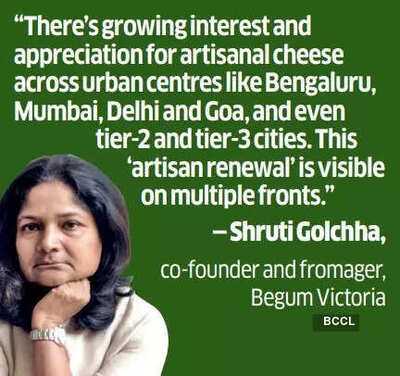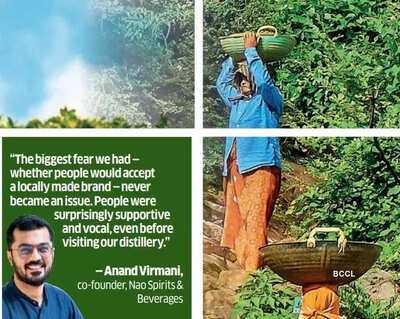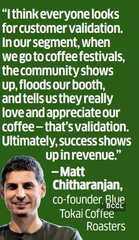The Oxford Dictionary describes craft as “an activity involving a special skill at making things with your hands”. But in the food and beverage industry, that definition only scratches the surface. Craft, to the modern-day crusaders of tradition and skill, is slow and thoughtful — a sweet, salty, botanical, caffeinated pass on the mass. And for the people behind it, it’s personal.
“Craft takes us back to a simpler time,” says Anand Virmani, co-founder, Nao Spirits & Beverages, the brand that makes craft gins such as Greater Than and Hapusa.
Rohit Pillai, director of product and growth, Bira 91, says, “For us, craft is thoughtful, unpretentious and for everyone.”
“Craft relies on sensory judgment — our trained eye, nose and hand,” explains Shruti Golchha, co-founder, Begum Victoria.
“Craft begins in the field,” shares Chaitanya Muppala, founder of Manam Chocolate, and CEO of Distinct Origins, which has featured in Time Magazine ’s list of World’s Greatest Places.
It’s clear that craft means different things to different people — even those in the business of producing it.
Growth chart
At the start of their craft journeys, brands had a blank slate. They were introducing a new category into the market; they had to start from the ground up, literally and figuratively. Educating the customer was as important as the cultivation of raw ingredients. “When we started, the specialty coffee category didn’t really exist domestically,” recalls Matt Chitharanjan, co-founder, Blue Tokai Coffee Roasters. “In the early days, we used to get complaints like, ‘I put hot water in your coffee, I put cold water in your coffee, but no matter what I do, it doesn’t dissolve.’ People would think the roast was off because they expected instant coffee. It took a lot of education to help them understand the small details that make the coffee taste the way it does,” he explains.
Virmani had to fight the “uncool” tag that gin had a decade ago, and be more hands-on with the brand’s marketing — even replying to customers directly on social media. “Gin had strange connotations; people thought it was for their grandparents, for day drinking, or just for women. It wasn’t considered a proper drink. We’d throw amazing events, and people would walk in and say, ‘Great party — can I get a glass of wine or whiskey?’” he says. Artisanal cheese also needed a tailored approach, “as consumers still equated cheese with processed cheese”, Golchha shares.
Communicating craft
Craft brands reveal that one of their biggest customer education challenges is convincing people that Indian produce can be specialty or premium. It’s still a pet peeve for Muppala. “When launching the brand or opening stores in new cities, people congratulate us, but quietly ask: “Where did you get this idea from?” as if Indians can only copy European culture. They can’t fathom that something complex and original can come from India.”
Their education syllabus? Focus on authentic storytelling, answer all the “geeky” questions about sourcing and production, social media visibility and, perhaps most importantly, in the digital age, get offline too.
“We once calculated that we have about 30,000 Instagram followers. Even if each bought one case a year — which is optimistic — that still leaves 70,000 cases unaccounted for. It shows how powerful word-of-mouth is. Most people discover us through recommendations, not Instagram. And since we’re not allowed to sell online, we’re not heavily invested in SEO or digital funnels,” explains Virmani.
For Golchaa, though, Instagram is a powerful tool, while “pop-ups, events and tastings” help them attract new customers.

Muppala says they use multiple touchpoints to communicate their ethos — through packaging, social media and storytelling — what they call ‘Manam Classrooms’. “This is where we hold engagement sessions that allow people to learn how to taste chocolate, understand flavour profiling, participate in handson workshops. We also travel across the country conducting educational sessions that demystify the chocolate-making process and equip people with the ability to distinguish between good, average and exceptional chocolate,” he adds.
Chitharanjan too champions the offline experience. But in Blue Tokai’s case, having their own cafés works well for them. He and co-founder Namrata Asthana even place orders themselves. “Nothing beats direct interaction with customers,” he says, adding that they spend a lot of time training staff, because no matter the coffee quality, if the team is rude or slow, the experience suffers. “You could be serving an 11/10 coffee, but the customer will be disappointed if the service is bad. So, we focus a lot on complementing the product with great service. ” Bira’s Pillai agrees, “Our taprooms are where our craft comes to life. These spaces let people taste, explore and give feedback in real time, which keeps our beers connected to what drinkers actually enjoy. We make sure that the story carries through to the bar, with bartenders trained to share the flavour and inspiration behind every pour.”

Selling a story
When it comes to their online marketing, brands need to have a strong narrative — why the brand exists and what makes their product better than mass-produced, lower-priced options. “This is best communicated through simple, jargonfree messaging,” says Nav Chatterji, partner principal at Lazy Eight, a brand innovation studio with presence in Delhi, Dubai and New York. “Many brands overuse jargon or throw around claims without testing. Consumers, especially in tier-1 and tier-2 cities, can see through that. If your product claims something, back it up with facts,” he adds.
This authenticity also needs to reflect in the people connected to the brand. “For influencer marketing, it’s important that they have credible backgrounds related to the product, rather than just celebrity endorsements,” Chatterji advises.

Packaging perks
Packaging is another important way craft brands can make themselves seen, especially if they can highlight India’s rich heritage and quality produce. “We were very conscious of not falling into clichés — no elephants, no snake charmers, no colonial imagery. We noticed that globally, gin brands were becoming overly ornate and hipster. We wanted to do the opposite — keep it minimal and clear, especially since India wasn’t yet a big market for craft gin,” says Virmani.
Manam sends out thousands of packages directly to homes and to a very defined target group — beautiful boxes celebrating India’s landscapes and artisans. “These are accessible and effective ways of communicating. A lot of what we do in terms of craft is expressed through them,” Muppala says. “For brands targeting exports to the US or Europe, the Indian element and origin should be deeply rooted in the brand’s DNA. For brands focused on Indian consumers, it’s enough to highlight ‘Made in India’ without going too deep into local specifics since Indian consumers are quite familiar already,” shares Chatterji.
But there’s an added element to craft: Knowing exactly where the product is coming from. People want to see, hear and connect with those involved in the process. Manam puts the name of the farmer on each bar; Blue Tokai celebrates each estate, which creates a deep emotional connection with consumers.
“Many premium Indian consumers want transparency — knowing where raw materials come from, who the farmers are, the production process, etc. Brands are moving away from being ‘black boxes’ to showing faces and stories behind their products,” adds Chatterji.
But, as is the worry with anything gaining popularity, the established massy brands may also want in. Case in point, Budweiser running a famous campaign about its craft credentials. But these craft brands aren’t fazed. As Chitharanjan says, most people in the craft space are doing it with thought and deliberation, not just trying to capitalise on a trend.
“That authenticity is important for the industry to grow and thrive,” he says.
“Craft takes us back to a simpler time,” says Anand Virmani, co-founder, Nao Spirits & Beverages, the brand that makes craft gins such as Greater Than and Hapusa.
Rohit Pillai, director of product and growth, Bira 91, says, “For us, craft is thoughtful, unpretentious and for everyone.”
“Craft relies on sensory judgment — our trained eye, nose and hand,” explains Shruti Golchha, co-founder, Begum Victoria.
“Craft begins in the field,” shares Chaitanya Muppala, founder of Manam Chocolate, and CEO of Distinct Origins, which has featured in Time Magazine ’s list of World’s Greatest Places.
It’s clear that craft means different things to different people — even those in the business of producing it.
Growth chart
At the start of their craft journeys, brands had a blank slate. They were introducing a new category into the market; they had to start from the ground up, literally and figuratively. Educating the customer was as important as the cultivation of raw ingredients. “When we started, the specialty coffee category didn’t really exist domestically,” recalls Matt Chitharanjan, co-founder, Blue Tokai Coffee Roasters. “In the early days, we used to get complaints like, ‘I put hot water in your coffee, I put cold water in your coffee, but no matter what I do, it doesn’t dissolve.’ People would think the roast was off because they expected instant coffee. It took a lot of education to help them understand the small details that make the coffee taste the way it does,” he explains.
Virmani had to fight the “uncool” tag that gin had a decade ago, and be more hands-on with the brand’s marketing — even replying to customers directly on social media. “Gin had strange connotations; people thought it was for their grandparents, for day drinking, or just for women. It wasn’t considered a proper drink. We’d throw amazing events, and people would walk in and say, ‘Great party — can I get a glass of wine or whiskey?’” he says. Artisanal cheese also needed a tailored approach, “as consumers still equated cheese with processed cheese”, Golchha shares.
Communicating craft
Craft brands reveal that one of their biggest customer education challenges is convincing people that Indian produce can be specialty or premium. It’s still a pet peeve for Muppala. “When launching the brand or opening stores in new cities, people congratulate us, but quietly ask: “Where did you get this idea from?” as if Indians can only copy European culture. They can’t fathom that something complex and original can come from India.”
Their education syllabus? Focus on authentic storytelling, answer all the “geeky” questions about sourcing and production, social media visibility and, perhaps most importantly, in the digital age, get offline too.
“We once calculated that we have about 30,000 Instagram followers. Even if each bought one case a year — which is optimistic — that still leaves 70,000 cases unaccounted for. It shows how powerful word-of-mouth is. Most people discover us through recommendations, not Instagram. And since we’re not allowed to sell online, we’re not heavily invested in SEO or digital funnels,” explains Virmani.
For Golchaa, though, Instagram is a powerful tool, while “pop-ups, events and tastings” help them attract new customers.
Muppala says they use multiple touchpoints to communicate their ethos — through packaging, social media and storytelling — what they call ‘Manam Classrooms’. “This is where we hold engagement sessions that allow people to learn how to taste chocolate, understand flavour profiling, participate in handson workshops. We also travel across the country conducting educational sessions that demystify the chocolate-making process and equip people with the ability to distinguish between good, average and exceptional chocolate,” he adds.
Chitharanjan too champions the offline experience. But in Blue Tokai’s case, having their own cafés works well for them. He and co-founder Namrata Asthana even place orders themselves. “Nothing beats direct interaction with customers,” he says, adding that they spend a lot of time training staff, because no matter the coffee quality, if the team is rude or slow, the experience suffers. “You could be serving an 11/10 coffee, but the customer will be disappointed if the service is bad. So, we focus a lot on complementing the product with great service. ” Bira’s Pillai agrees, “Our taprooms are where our craft comes to life. These spaces let people taste, explore and give feedback in real time, which keeps our beers connected to what drinkers actually enjoy. We make sure that the story carries through to the bar, with bartenders trained to share the flavour and inspiration behind every pour.”
Selling a story
When it comes to their online marketing, brands need to have a strong narrative — why the brand exists and what makes their product better than mass-produced, lower-priced options. “This is best communicated through simple, jargonfree messaging,” says Nav Chatterji, partner principal at Lazy Eight, a brand innovation studio with presence in Delhi, Dubai and New York. “Many brands overuse jargon or throw around claims without testing. Consumers, especially in tier-1 and tier-2 cities, can see through that. If your product claims something, back it up with facts,” he adds.
This authenticity also needs to reflect in the people connected to the brand. “For influencer marketing, it’s important that they have credible backgrounds related to the product, rather than just celebrity endorsements,” Chatterji advises.
Packaging perks
Packaging is another important way craft brands can make themselves seen, especially if they can highlight India’s rich heritage and quality produce. “We were very conscious of not falling into clichés — no elephants, no snake charmers, no colonial imagery. We noticed that globally, gin brands were becoming overly ornate and hipster. We wanted to do the opposite — keep it minimal and clear, especially since India wasn’t yet a big market for craft gin,” says Virmani.
Manam sends out thousands of packages directly to homes and to a very defined target group — beautiful boxes celebrating India’s landscapes and artisans. “These are accessible and effective ways of communicating. A lot of what we do in terms of craft is expressed through them,” Muppala says. “For brands targeting exports to the US or Europe, the Indian element and origin should be deeply rooted in the brand’s DNA. For brands focused on Indian consumers, it’s enough to highlight ‘Made in India’ without going too deep into local specifics since Indian consumers are quite familiar already,” shares Chatterji.
But there’s an added element to craft: Knowing exactly where the product is coming from. People want to see, hear and connect with those involved in the process. Manam puts the name of the farmer on each bar; Blue Tokai celebrates each estate, which creates a deep emotional connection with consumers.
“Many premium Indian consumers want transparency — knowing where raw materials come from, who the farmers are, the production process, etc. Brands are moving away from being ‘black boxes’ to showing faces and stories behind their products,” adds Chatterji.
But, as is the worry with anything gaining popularity, the established massy brands may also want in. Case in point, Budweiser running a famous campaign about its craft credentials. But these craft brands aren’t fazed. As Chitharanjan says, most people in the craft space are doing it with thought and deliberation, not just trying to capitalise on a trend.
“That authenticity is important for the industry to grow and thrive,” he says.
You may also like

UP tables Bill to form Banke Bihari trust

BREAKING: PSG stage epic comeback to stun Tottenham and win Super Cup on penalties

'Stay away' from 'Frankenrabbits' found with black tentacles growing from heads

Moses Itauma's trainer makes 'dog fight' admission ahead of Dillian Whyte fight

Met Office tells Brits in 38 areas to prepare 'emergency' kit with three items







